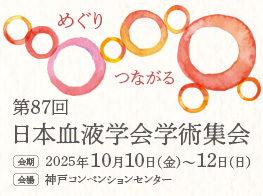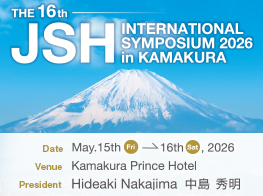
名前:小林 匡洋 【東北大学血液免疫科】
発表日時:2013年6月15日
発表形式:Oral
Title:
Iron deficient anemia involves reconfiguration of erythropoietic program orchestrated by heme receptor Bach1
Authors:
Masahiro Kobayashi 1, 2,*, Akihiko Muto 1, Ari Itoh-Nakadai 1, Tohru Fujiwara 2, Naohisa Tomosugi 3, Hideo Harigae 2, Kazuhiko Igarashi 1
Affiliations:
1Department of Biochemistry, 2Department of Rheumatology and Hematology, Tohoku University Graduate School of Medicine, Sendai, 3Proteomics Research Unit, Division of Advanced Medicine, Medical Research Institute, Kanazawa Medical College, Kanazawa, Japan
Abstract:
Background
Developing erythroid cells must synthesize balanced amounts of globin proteins and heme because of their intrinsic toxicities. Free globin proteins without heme precipitate easily, causing proteotoxicity, whereas free heme produces reactive oxygen species. Since iron deficient anemia (IDA) is one of the most prevalent diseases, coordination of globin and heme syntheses according to available iron level in erythroid cells must be critical. It has been considered that living bodies have exquisite systems, which sense the amount of iron or heme to regulate globin synthesis and erythropoiesis. While heme-regulated eIF2a kinase HRI is known to regulate the translation of globin by sensing heme, little is known about the transcriptional mechanism for balancing heme and globin levels. In vitro studies have shown that BTB and CNC homology1 (Bach1) is a heme-binding transcriptional repressor and binds to the -globin locus control region and the enhancer regions of Hmox1 encoding heme oxygenase-1 (HO-1). Heme binds to Bach1 to inhibit its DNA binding and to induce its degradation, achieving derepression of Bach1 target genes. Based on these lines of evidence, we hypothesized that Bach1 would adapt synthesis of globin according to heme and iron levels.
Aims
To clarify the function of Bach1 during erythropoiesis under IDA.
Methods
Bach1-deficient mice were used for the analysis. To induce iron deficient anemia, the mice were fed with low iron diet. Erythroid progenitors were separated from flow cytometry. Quantitative chromatin immunoprecipitation (ChIP) analysis was performed with TER119-positive erythroblasts using anti-MafK (Santa Cruz) and anti-Bach1 serum A1-6 (Sun et al., 2004). Serum hepcidin level was determined with LC-MS/MS method.
Results
Bach1-deficient mice did not exhibit defects in erythropoiesis. In contrast, we found aggravation of IDA in Bach1-deficient mice. Based on electron microscopic analysis, massive aggregates were observed in peripheral red blood cells under IDA in Bach1-deficient mice, presumably reflecting denatured globin. While expression of both HO-1 and globin mRNA expressions was repressed in wild-type erythroblasts upon iron depletion, their expression was higher in Bach1-deficient erythroblasts. ChIP analysis confirmed endogenous Bach1 occupancy at the regulatory regions of these genes. Changes in the systemic iron distribution are also predisposing factors for IDA. Thus, we next assessed serum hepcidin, known as a main regulator of systemic iron level. We found that the serum hepcidin level was significantly higher in Bach1-deficient mice.
Summary / Conclusion
We propose a model, referred to as “hemoglobin regulon”, in which the balance between heme and globin in iron deficient erythroid cells is coordinated through Bach1. In iron deficient erythroid cells, heme concentration is decreased, leading to the activation of Bach1 and thereby an inhibition of globin gene transcription. The expression of HO-1 is also kept low in iron deficient erythroid cells, precluding degradation of the newly synthesized heme using the scarce iron. Therefore, both heme and globin are maintained to similar levels by Bach1 and an accumulation of harmful excessive globin is avoided. IDA is not a mere result of iron shortage but is based on an adaptive gene response within erythroid cells. In addition, Bach1 represses hepcidin expression and thereby regulates systemic iron homeostasis. Heme-initiated transcriptional regulations by Bach1 are essential for erythropoiesis and iron homeostasis.
EHAに参加した感想
18th Congress of EHA は2013年6月12日から16日まで、スウェーデンのストックホルムで開催されました。 ストックホルムは北欧のベニスとも呼ばれるそうです。海に面した町並みや、ヨーロッパらしい建築が昔のまま残る旧市街は、とても美しい風景でした。学会期間中は白夜で、午後11時頃まで明るさが残り、不思議な感覚で毎日を過ごしました。公共交通機関の乗り場でEHA参加章を提示すれば、ストックホルム市近郊までの範囲でバスや電車に自由に乗ることができました。近郊にも公園や自然が多い街で、比較的落ち着いた雰囲気の街でした。
会場はAlvsjoという、ストックホルム市中心部のストックホルム中央駅から南に電車で15分ほどの場所でした。
私は、“Red blood cell biology”のテーマで口頭発表しました。私はヘムに結合するBach1という転写因子に注目し、鉄欠乏性貧血で赤血球造血を維持するためには、Bach1による転写制御が必要であることを示しました。鉄欠乏の赤血球自体でBach1がヘムとグロビンの均衡を転写レベルで維持するという「Hemoglobin regulon model」を提唱しました。また、Bach1欠損マウスでは、鉄代謝に重要なヘプシジンの血清濃度が上昇することも報告しました。鉄やヘムに応じたヘプシジン制御では、Bach1を介する経路が存在する可能性があるという新しいモデルを提唱しました。質問では、慢性炎症による貧血やサラセミアに関連した、ヨーロッパらしいとも思える質問や指摘があり、今後の課題となる点であると考えられます。赤血球系や鉄代謝を題材とした他の演題にも刺激を受けました。鉄過剰マウスの研究も発表されており、ヘプシジン遺伝子の発現など興味深い結果が報告されていました。私の研究対象のBach1 と標的配列が同一と考えられるNF-E2についての報告もあり、NF-E2がヘム合成酵素の遺伝子発現を正に制御する可能性が示されていました。自分の取り組んでいる研究についてさらに興味を深める機会となり、今後もさらに追求すべき点が残されていると改めて感じました。
今回、EHA travel awardとして採択して頂き大変光栄に思います。他の採択された先生方も、全員口頭発表であったと伺いました。日本の研究者の発表が評価されたことを、うれしく思います。日本血液学会の先生方、事務局の方々の何年にも渡るご尽力があったからこそ、日本の若手の研究者の発表がますます注目されてきたのではないかと感じます。これからも注目されるような発表を日本から数多く発信し、ヨーロッパの血液学分野の研究者に良い意味で緊張感を与えることが、これからの日本の若手研究者の使命ではないかと思います。今回採択された他の先生方や日本血液学会の役員の先生方とも交流することができ、貴重な機会となりました。このような素晴らしい機会を与えてくださった日本血液学会の先生方、事務局の皆様に心より感謝いたします。




